Captive Bread
New member
I've wanted newts since I was little and read about them in books and was fascinated by the idea of a frog that looks like a lizard. Fast forward to now and I have have two robust specimens of Triturus marmoratus, the holy Marbled Newt! I received them six months ago from @Herpin Man but I wanted to keep quiet about it for this long in case I killed them. Alas they are alive and well. One is a male born in 2020 I named De Gaulle, and the other is a female born in 2021 named Marie. French names to be fitting.
I keep them 100% terrestrial as I am not ready for the headaches of aquarium ownership for another year (Italian Alpines probably?). The vivarium is a 20 gallon long with a tight screen lid as advised. No electronics other than a 20 dollar grow light from the hardware store with a timer. The soil is all organic potting soil mixed 4:1 with dead sphagnum moss and leaf litter. All of it is suspended over a drainage layer with a window screen sheet cut out.
The plants include common thyme (the big plant with little leaves in the back), spearmint on the right (yes it looks all jacked up, I don't know why it grows like that), floor moss (which wants to kill itself), Pothos on the left which I only have because the newts like it (waxy leaves don't fit the temperate forest vibe) and thread moss on the bark I gathered which is probably my favorite piece of flora in there.
Fungus is the generic run of mold and mildew, which I love dearly for its nutrient transfer. I've seen a mushroom once but it got toppled by De Gaulle before I could get a good picture...
Additional fauna includes pill bugs for clean up, fungus gnats (really annoying but oh well), weird little beetles that appear to eat bark, predator mites which are finally going extinct in there, spider mites which thankfully are dying out also, and spring tails which sadly got out competed. Some black worms are in there but they are very rare. I imagine the soil is extremely active with microscopic biodiversity that only promotes the stability of the system.
The newts are nocturnal so they spend a lot of time sleeping in the day but they love to rummage at dusk and dawn or they go under shade. A lot of their time is spent hunting the clean up crew. Yes, that is probably my favorite part of this whole system, it's darn near self sustaining. I feed my newts thawed mysis shrimp once every two weeks or when they get thin, for the rest of it they sustain themselves off of the gnats and pill bugs. I conduct extremely little of maintenance, I thought I would be far busier.
Overall, keeping salamanders has been a delight. I have a rectangular prism of forest cut out and transplanted directly into my otherwise sterile apartment. I hope for many good years with my "marbs" and will periodically post updates to this thread.
Fun Observations:
•Marie is smart. She knows all the good spots for hunting bugs in the enclosure. De Gaulle hopes to chance upon it. De Gaulle is brave though and comes to the glass to beg me for shrimp. Marie is timid.
•The will actually chase a laser pointer.
•Whoa, they breathe like frogs. I was surprised to see their mouth undulates to move air, they don't use a diaphragm.
•Their tails are somewhat prehensile. I kind of expected their tails to only come into effect when they get aquatic, but it actually serves them as another limb to hold onto things.
•When they want to move, they move FAST. But only for live prey.
•They actually prefer lower moisture levels. My initial understanding of amphibians is that all species require dart frog levels of humidity, with a fogger essentially dumping water in every hour. T. marmoratus likes it drier. Heck, their skin is hydrophobic and rebels humidity. I mist the enclosure only once a day, mostly for the plants. Even then, I still host a "drought day" every so often to offset over-watering. Maybe once a week do they dip in and out of the water dish.
•Newts have slow metabolisms. Good grief, I was worried I would be going through a carton of bloodworms per month. Initially I tong fed them twice a week and they got FAT. I had to slow way, way down and offer food very rarely.
•I was told stem plants are a pain and that moss is impossible to kill. I have found the exact opposite to be true.
•Because they share so much in common with frog biology, I could google all my problems with respect to frogs and find answers when I had problems.
I keep them 100% terrestrial as I am not ready for the headaches of aquarium ownership for another year (Italian Alpines probably?). The vivarium is a 20 gallon long with a tight screen lid as advised. No electronics other than a 20 dollar grow light from the hardware store with a timer. The soil is all organic potting soil mixed 4:1 with dead sphagnum moss and leaf litter. All of it is suspended over a drainage layer with a window screen sheet cut out.
The plants include common thyme (the big plant with little leaves in the back), spearmint on the right (yes it looks all jacked up, I don't know why it grows like that), floor moss (which wants to kill itself), Pothos on the left which I only have because the newts like it (waxy leaves don't fit the temperate forest vibe) and thread moss on the bark I gathered which is probably my favorite piece of flora in there.
Fungus is the generic run of mold and mildew, which I love dearly for its nutrient transfer. I've seen a mushroom once but it got toppled by De Gaulle before I could get a good picture...
Additional fauna includes pill bugs for clean up, fungus gnats (really annoying but oh well), weird little beetles that appear to eat bark, predator mites which are finally going extinct in there, spider mites which thankfully are dying out also, and spring tails which sadly got out competed. Some black worms are in there but they are very rare. I imagine the soil is extremely active with microscopic biodiversity that only promotes the stability of the system.
The newts are nocturnal so they spend a lot of time sleeping in the day but they love to rummage at dusk and dawn or they go under shade. A lot of their time is spent hunting the clean up crew. Yes, that is probably my favorite part of this whole system, it's darn near self sustaining. I feed my newts thawed mysis shrimp once every two weeks or when they get thin, for the rest of it they sustain themselves off of the gnats and pill bugs. I conduct extremely little of maintenance, I thought I would be far busier.
Overall, keeping salamanders has been a delight. I have a rectangular prism of forest cut out and transplanted directly into my otherwise sterile apartment. I hope for many good years with my "marbs" and will periodically post updates to this thread.
Fun Observations:
•Marie is smart. She knows all the good spots for hunting bugs in the enclosure. De Gaulle hopes to chance upon it. De Gaulle is brave though and comes to the glass to beg me for shrimp. Marie is timid.
•The will actually chase a laser pointer.
•Whoa, they breathe like frogs. I was surprised to see their mouth undulates to move air, they don't use a diaphragm.
•Their tails are somewhat prehensile. I kind of expected their tails to only come into effect when they get aquatic, but it actually serves them as another limb to hold onto things.
•When they want to move, they move FAST. But only for live prey.
•They actually prefer lower moisture levels. My initial understanding of amphibians is that all species require dart frog levels of humidity, with a fogger essentially dumping water in every hour. T. marmoratus likes it drier. Heck, their skin is hydrophobic and rebels humidity. I mist the enclosure only once a day, mostly for the plants. Even then, I still host a "drought day" every so often to offset over-watering. Maybe once a week do they dip in and out of the water dish.
•Newts have slow metabolisms. Good grief, I was worried I would be going through a carton of bloodworms per month. Initially I tong fed them twice a week and they got FAT. I had to slow way, way down and offer food very rarely.
•I was told stem plants are a pain and that moss is impossible to kill. I have found the exact opposite to be true.
•Because they share so much in common with frog biology, I could google all my problems with respect to frogs and find answers when I had problems.
Attachments
-
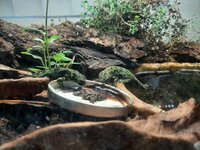 20220818_083940.jpg2.4 MB · Views: 949
20220818_083940.jpg2.4 MB · Views: 949 -
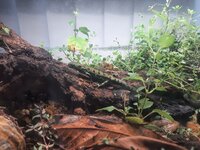 20220919_081830.jpg3 MB · Views: 439
20220919_081830.jpg3 MB · Views: 439 -
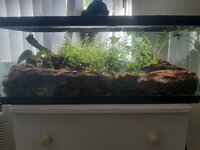 20221029_085153.jpg2.7 MB · Views: 440
20221029_085153.jpg2.7 MB · Views: 440 -
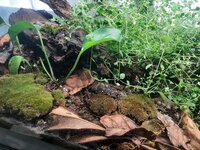 20221029_085240.jpg3.7 MB · Views: 429
20221029_085240.jpg3.7 MB · Views: 429 -
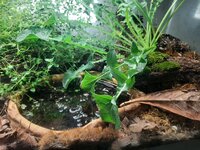 20221029_085246.jpg3.1 MB · Views: 459
20221029_085246.jpg3.1 MB · Views: 459 -
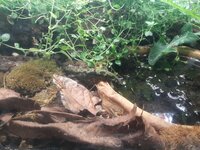 20221029_093842.jpg3.9 MB · Views: 420
20221029_093842.jpg3.9 MB · Views: 420 -
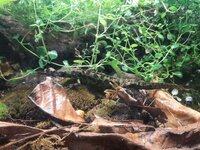 20221030_081022.jpg3.1 MB · Views: 440
20221030_081022.jpg3.1 MB · Views: 440 -
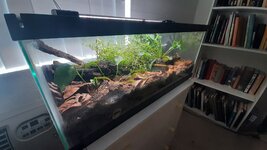 20221030_113151.jpg1.3 MB · Views: 482
20221030_113151.jpg1.3 MB · Views: 482
